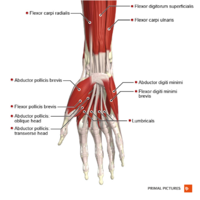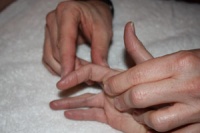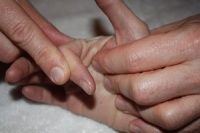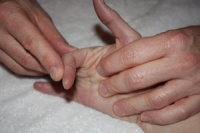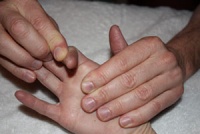Bunnell-Littler Test: Difference between revisions
Rachael Lowe (talk | contribs) No edit summary |
No edit summary |
||
| (44 intermediate revisions by 7 users not shown) | |||
| Line 1: | Line 1: | ||
<div class="editorbox"> | |||
'''Original Editor ''' - [[User:Jon DeVaul|Jon DeVaul]] | |||
Original Editor - | |||
'''Top Contributors''' - {{Special:Contributors/{{FULLPAGENAME}}}} | |||
</div> | |||
== Purpose == | |||
| | [[Image:Muscles_of_the_hand_anterior_aspect_Primal.png|thumb|right|200px|Image courtesy of Primal Pictures]] | ||
< | This test evaluates the source of PIP flexion motion limitation by differentiating between intrinsic muscle or capsular tightness in the affected digit. A typical patient presentation may include pain located in the distal intermetacarpal space and with prolonged gripping or making a fist. Symptoms are most often seen in the ring and long finger.<ref name="text">Donatelli RA, Wooden MJ editors: Orthopaedic Physical Therapy, ed 4, St Louis, 2010, Churchill Livingston.</ref> | ||
== | == Technique == | ||
The MCP joint is held in an extended position and the therapist passively flexes the PIP making note of the available range. The test is then repeated with the MCP joint flexed. If no change in motion is detected between the two tests, then capsular restriction at the PIP joint is implicated. If the motion increases when the MCP joint is flexed, then lumbricale muscle tightness is implicated.<ref name="guide">Konin JG, Wiksten DL, Isear Jr., JA, Brader H. Special Tests for Orthopedic Examination, ed 2, Thorofare NJ, 2002, SLACK.</ref> | |||
== | {| width="100%" cellspacing="1" cellpadding="1" border="0" align="center" | ||
|- | |||
| [[Image:B l test start.jpg|thumb|center|200px|Positive test finding for PIP restriction]] | |||
| [[Image:B l end intrinsic.jpg|thumb|center|200px|Increased PIP flexion with MCP flexion implies intrinsic restriction]] | |||
| [[Image:B l end capsular.jpg|thumb|center|200px|No increase in PIP flexion with MCP flexion implies capsular restriction]] | |||
| [[Image:B l normal.jpg|thumb|center|200px|Full PIP flexion with MCP extension is a normal (negative) test finding]] | |||
|} | |||
{{#ev:youtube|GpBrc5CIEVk|400}}<ref> Bunnell-Littler Test AKA Finochietto-Bunnell Test Available from: https://www.youtube.com/watch?v=GpBrc5CIEVk [last accessed 28/2/2021]</ref> | |||
== Evidence == | == Evidence == | ||
While referred to in many searched texts and articles, no search of Pubmed, Medline, or Medscape produced results pertaining to the specificity or sensitivity of this test by the name Bunnell-Littler, or the associated name Finochietto-Bunnell test. | |||
== Resources == | == Resources == | ||
*Orthopaedic Physical Therapy by Donatelli and Wooden. 4th edition. | |||
*Special Tests for Orthopedic Examination by Konin, Wiksten, Isear, and Brader. 2nd edition. | |||
== References | == References == | ||
<references /> | <references /> | ||
[[Category:Assessment]] | |||
[[Category:Hand - Assessment and Examination]] | |||
[[Category:Hand]] | |||
[[Category:Musculoskeletal/Orthopaedics]] | |||
[[Category:EIM_Residency_Project]] | |||
[[Category:Rehabilitation Foundations]] | |||
[[Category:Special Tests]] | |||
[[Category:Hand - Special Tests]] | |||
Latest revision as of 16:40, 28 February 2021
Original Editor - Jon DeVaul
Top Contributors - Jon DeVaul, Admin, Kim Jackson, Rachael Lowe, Laura Ritchie, Evan Thomas, Fasuba Ayobami and Claire Knott
Purpose[edit | edit source]
This test evaluates the source of PIP flexion motion limitation by differentiating between intrinsic muscle or capsular tightness in the affected digit. A typical patient presentation may include pain located in the distal intermetacarpal space and with prolonged gripping or making a fist. Symptoms are most often seen in the ring and long finger.[1]
Technique[edit | edit source]
The MCP joint is held in an extended position and the therapist passively flexes the PIP making note of the available range. The test is then repeated with the MCP joint flexed. If no change in motion is detected between the two tests, then capsular restriction at the PIP joint is implicated. If the motion increases when the MCP joint is flexed, then lumbricale muscle tightness is implicated.[2]
Evidence[edit | edit source]
While referred to in many searched texts and articles, no search of Pubmed, Medline, or Medscape produced results pertaining to the specificity or sensitivity of this test by the name Bunnell-Littler, or the associated name Finochietto-Bunnell test.
Resources[edit | edit source]
- Orthopaedic Physical Therapy by Donatelli and Wooden. 4th edition.
- Special Tests for Orthopedic Examination by Konin, Wiksten, Isear, and Brader. 2nd edition.
References[edit | edit source]
- ↑ Donatelli RA, Wooden MJ editors: Orthopaedic Physical Therapy, ed 4, St Louis, 2010, Churchill Livingston.
- ↑ Konin JG, Wiksten DL, Isear Jr., JA, Brader H. Special Tests for Orthopedic Examination, ed 2, Thorofare NJ, 2002, SLACK.
- ↑ Bunnell-Littler Test AKA Finochietto-Bunnell Test Available from: https://www.youtube.com/watch?v=GpBrc5CIEVk [last accessed 28/2/2021]
